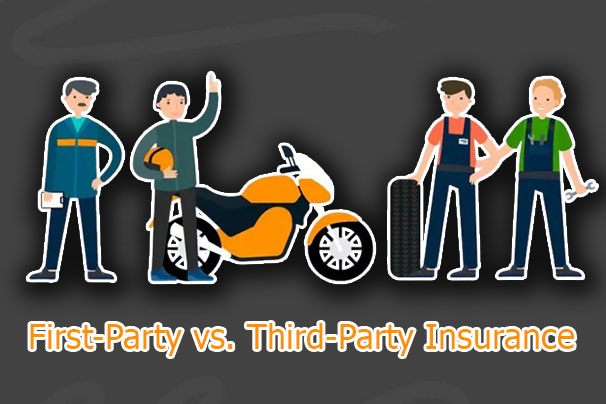
First-Party vs. Third-Party Insurance: What’s the Difference – When exploring the world of insurance, it is important to be familiar with and understand the differences between the various forms of coverage. Among the different types of coverage, we have first-party and third-party insurance. Accordingly, these categories of insurance have different and unique purposes as well as benefits in certain situations.

This leads us to the question: first-party vs. third-party insurance: what’s the difference? Since both insurance types have different purposes, they will also have major differences in all aspects like benefits, features, and coverage. That is what we will be exploring in this article. Without further ado, let us get into it.
What is First-Party Insurance?
First-party insurance is a type of insurance specifically designed to cover the damages or losses experienced or suffered by the policyholder directly. What’s more, this form of insurance offers financial protection and security for the property, well-being, and health of the insured or policyholder.
It also handles illnesses, damages, and accidents that can personally affect the policyholder. Radically, the policyholder is both the receiver or beneficiary of the provided benefits and the first party of the insurance quote.
Examples of First-Party Insurance?
Here are the common forms of first-party insurance:
- Homeowners insurance.
- Health insurance.
- Travel insurance.
- Auto insurance.
- Collision coverage.
- Personal injury protection.
- Renters insurance.
- MedPay coverage.
- Underinsured/Uninsured motorist protection.
- Rental imbursement.
- GAP insurance.
First-Party Insurance Benefits
There are several advantages to getting or having a first-party insurance policy. They include:
- Personalized policies.
- Direct coverage.
- Increased coverage options.
- Peace of mind.
- Financial security.
- Swift claims processing.
- Comprehensive protection.
What is Third-Party Insurance?
On the other hand, third-party insurance offers loss and damage coverage that the insured or policyholder is responsible for legally, which affects another party or individual.
Accordingly, this form of insurance coverage is designed specifically to offer protection to policyholders from financial obligations for claims made by a third party for property damage or injuries.
In addition, the term “third party” refers to a person who is not the first party (the insured) and the second party (the insurance provider).
Examples of Third-Party Insurance
Here are the common forms of third-party insurance:
- Employer’s liability insurance.
- Auto liability insurance.
- Product liability insurance.
- Business insurance.
- Professional liability insurance (Errors and Omissions coverage).
- Bodily injury liability insurance.
- Medical malpractice insurance.
- Business Owners Policy (BOP).
- Property damage liability.
Third-Party Insurance Benefits
There are several perks and benefits to having or getting a third-party insurance policy. They are as follows:
- Compliance with legal requirements.
- Legal claims protection.
- Increased credibility.
- Financial security and protection for businesses.
- Different event coverage.
- Reduced personal liability.
- Protection for professionals against negligence and claims of errors.
First-Party vs. Third-Party Insurance: What’s the Difference?
In this section of this blog post, we will be discovering the differences between first-party insurance and third-party insurance. Here is what you need to know about these forms of coverage and what situations they work best in:
| First-Party Insurance | Third-Party Insurance | |
| Primary Coverage | Covers the damages and losses of the policyholder | Covers liabilities and damages to other parties |
| Types of Coverage | Homeowners, health, travel, comprehensive, and many more | professional liability, auto liability, product liability public liability, employer’s liability, and more |
| Claimant | Policyholder | Third-party |
| Claims Process | Usually straightforward | Might be complicated due to external parties |
| Purpose | Offers income, personal property, and health coverage | Offers legal claims and liability coverage |
| Personalization | Highly | Usually standardized |
| Role of Policyholder | Benefits from coverage | Third parties benefit from such coverage. |
| Policy Purchase | First party | First party |
| Examples | Comprehensive coverage, health, travel, homeowners, GAP insurance, rental reimbursement, and many more | Auto liability, product liability, BOP, professional liability, business, property damage, employer’s liability insurance, and many more |
| Legal Requirements | Optional | Mandatory |
| Accident Coverage | The first party receives compensation. | The third party gets compensated. |
Do I Need First-Party or Third-Party Insurance?
The answer to whether or not you need first-party or third-party insurance depends on your risks and needs. Meanwhile, first-party insurance is beneficial if you are looking to protect your own income, health, or income.
On the other hand, you should consider third-party insurance if you are looking for coverage for possible legal damages or liabilities caused to others. Most of the time, businesses and individuals find both types of insurance advantageous as they offer comprehensive protection and security.
Frequently Asked Questions
Can I have both first-party and third-party insurance?
Yes, it is possible to have both first-party and third-party insurance, as they cover different liabilities and risks. For instance, a vehicle owner may have both liability insurance (third-party) and comprehensive auto insurance (first-party).
How do I know how much third-party insurance I need?
The required amount of third-party insurance depends on various factors like your local regulations, profession, and the nature of your business. It is advisable to ask for assistance from an insurance professional.
Is first-party insurance mandatory?
Some of the types of first-party insurance like auto insurance and health insurance are mandatory in some jurisdictions. However, based on one’s personal needs, these types of first-party insurance are optional.